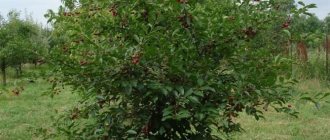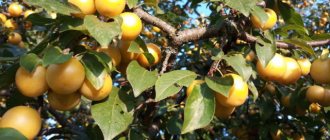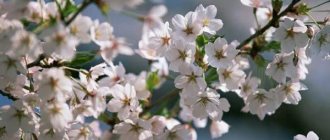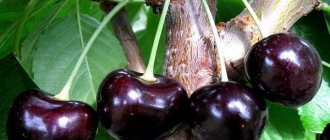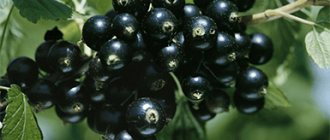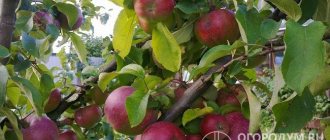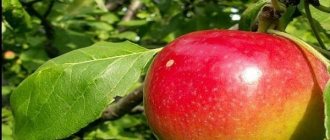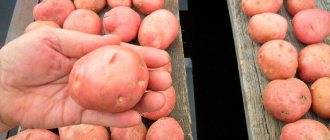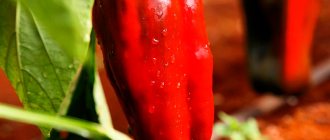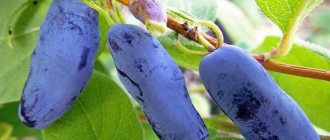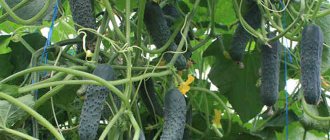Vladimir cherry is a century-old and one of the most popular cherry varieties in Russia with medium-ripe fruits. The Vladimirskaya variety is characterized by frost resistance, productivity, as well as the taste of the berries and their high transportability.
Cherry Vladimirskaya
Vladimir cherries are dense, juicy, and have a pleasant sweet and sour taste.
Vladimir cherry is frost-resistant
Description of the variety
The existence of the Vladimirsky variety dates back more than three centuries. The variety, with the characteristics that we are accustomed to now, appeared in 1993 as a result of crossing the Vladimir cherry with the Lyubskaya.
Description of the tree and its fruits:
- bushes , 2.5-5 meters high. When grafted, these are single-stemmed trees.
- The stem and main branches have gray flaky bark that has longitudinal cracks.
- The crown is round, spreading, weeping.
- Young shoots are yellowish-brown, drooping.
- The leaves are medium-sized, dull, and have a rich dark green color.
- The flowers are medium-sized, saucer-shaped, white.
- The fruits of “Vladimirskaya” are small or medium, weighing from 2.5 to 3.4 grams. The shape of the cherry is flat and round. The skin of the berries is black and red with many gray dots. The pulp is dark red, dense, juicy, and has a pleasant sweet and sour taste. The further south the cherry growing area, the more sugar there is in the fruit.
Characteristics of the variety
A characteristic feature of the variety is the rather weak cover of the crown with foliage and the shape of the leaves themselves, as if folded along the central vein. The length of the smooth dark green leaf blades is 80-90 mm, the width is half that.
The leaves are elongated-oval with a pointed apex, have biconvex serrated edges and are attached to the shoots by small strong cuttings of a reddish color. Vladimirskaya cherry is a mid-season variety. The taste and quality of the berries depends on the region and growing conditions.
Resistance to adverse factors
The resistance of Vladimir cherry to cold is assessed as good, but at low temperatures (-30°C) in winter, damage to fruit buds is possible, which leads to a reduction in yield. This quality prevents the spread of this cherry in the northern regions of central Russia.
The yield of Vladimir cherries depends on weather conditions and the growing region. In general, the productivity of the variety is moderate to good. In the conditions of Central Russia, the bush brings 25 kg of fruit, in the north - 5 kg per bush. Pollinators are needed for high yields.
According to gardeners, growing this variety in the south is problematic - it has low drought resistance and requires preventive treatment and good care.
Growing regions
Vladimirskaya is a variety of Common Cherry (Prunus cerasus), accepted by the State Register in 1947. The variety is recommended for planting in the following regions:
- Central District;
- Central Black Earth District;
- in North-west;
- Middle Volga region.
Pollinators, flowering and ripening period
Cherries can bloom very profusely in the spring, which is not an indicator of a rich harvest in the future. The key to high fruiting is high-quality pollination of the cherry or shrub by insects or a pollinating plant.
The Vladimirskaya cherry variety is self-sterile; it needs 2-3 varieties of pollinators. Therefore, he needs a neighborhood of cherries of a certain variety:
- Rastunya;
- Amorelle pink;
- Turgenevka;
- Zhukovskaya;
- Vasilievskaya;
- Lyubskaya;
- Morel black.
Productivity, fruiting and taste
The grafted Vladimirskaya cherry begins to bear fruit no earlier than 2 years after planting; for ungrafted trees of this variety, the period increases to 4-5 years. In the central part of the country, more than 20 kg of cherries are collected from one tree of the Vladimirskaya variety.
Mass ripening of the crop is not typical for the variety. Fruits of small or medium size, depending on climatic and weather conditions, are ready for harvest from July 10 to July 25. Weight 2.5-3.5 g. Round shape, slightly flattened at the side seam.
The funnel is shallow. The color is burgundy, almost black, with gray specks under the skin. The pulp is dense, dark red in color, juicy. The taste is sweet with a slight sourness.
According to the chemical composition, fruits grown in northern latitudes (St. Petersburg) contain:
- dry matter 16.4%;
- free acids 1.7%;
- total sugars 10.9%;
- ascorbic acid 26.6 mg/100 g wet weight.
Berries grown in the Krasnodar Territory (Maikop) contain:
- dry matter 18.5%;
- free acids 0.67%;
- total sugars 11.46%;
- ascorbic acid 4.6 mg/100 g.
Area of application of berries
The fruits are highly rated on the tasting scale due to their excellent taste. In terms of use, the grade is universal, suitable for the production of high-quality processed products (freezing, dried fruits, preserves, compotes).
Advantages and disadvantages
The advantages of the Vladimirskaya cherry variety have been tested over the years. But, of course, there are also disadvantages.
| Advantages | Flaws |
The following advantages of the variety are highlighted:
| There are 6 disadvantages:
|
Advantages and disadvantages of Vladimir cherry
Gardeners who grow Vladimir cherries in areas with a temperate climate note its advantages when characterizing this variety. One of its main advantages is considered to be high-quality fruits of universal use and high yield. With proper care, you can harvest 25 kg of ripe cherries from a mature tree. The tree is unpretentious, quickly acclimatizes and gets used to growing in a new area. Good frost resistance allows you not to worry about insulating the tree for the winter. The fruits are early-bearing and have good taste. In this case, the seed is easily separated from the fruit.
As a sign of love for this fruit tree, a monument was erected in the historical part of Vladimir.
Despite the advantages of cherries, a description of the variety would be incomplete without listing the disadvantages. This:
- reduced frost resistance of generative buds;
- susceptibility to fungal diseases - coccomycosis and moniliosis.
Productivity directly depends on climatic conditions. In addition, the variety is self-sterile. Another disadvantage is that untimely harvesting leads to shedding of ripened fruits.
Landing Features
The best time to plant cherries is in the spring. To do this, seedlings purchased in the fall are dug up or stored in the basement, sprinkling the roots with wet sawdust. Cherries should be planted in pairs with a pollinator. The root system should be branched and fibrous.
The roots are no shorter than 30-35 cm, light when cut. They should not be swollen or damaged. The size of the hole depends on the soil; the more fertile the soil, the shallower the depth of the hole. In the middle zone, on heavy loamy soils, holes are made with a diameter of 1 m and a depth of 70-80 cm.
When planting cherries, add the following to the hole:
- 10 kg of humus;
- 60 g superphosphate;
- 60 g of potassium chloride.
When planting, the root neck of the cherry should rise 5-8 cm above the ground. Before planting, the roots of the seedling should be soaked for several hours in a growth stimulator.
Optimal timing
Cherries grown in a container, that is, having a closed root system, can be planted throughout spring and summer, but no later than a month before the onset of frost. The best time to plant cherries in the spring is the first half of April.
In warmer regions this will be the beginning of the month, in colder regions it will be towards the end. It is important to plant before the buds open and when the ground warms up. A plant planted at the optimal time will take root better and be more resistant to various weather conditions.
Choosing a landing site
Cherry is a heat-loving plant, so you need to start planting by choosing a place - the sunniest part of the garden. When planting several seedlings, you need to leave a distance of 3-4 m between the holes so that the overgrown bushes do not interfere with each other.
The planting area must be well ventilated; cherries do not tolerate stagnant cold air. She does not like swampy, cold and acidic soils, lowlands, or high groundwater levels. Cherry does not grow well in sandy soils.
What can and cannot be planted next to the Vladimir cherry
Vladimirskaya cherry does not tolerate the proximity of such trees and bushes:
- pear;
- Apple tree;
- black currant;
- red rowan;
- raspberries;
- sea buckthorn;
- gooseberry.
The best neighbors for her are:
- cherries (without which pollination is impossible);
- plums;
- cherry plum;
- elder;
- grape;
- Rowan.
Rules of care
Like other crops, the Vladimirskaya cherry variety requires constant, proper care, which consists of organizing watering, maintaining the root system, timely feeding and pruning, and preparing for winter cold.
Irrigation
Trees require rare but abundant watering. Water should saturate the entire root system, but at the same time not prevent the penetration of sufficient oxygen. Until the cherry tree bears fruit, it needs to be watered only 4-5 times per season. For uniform irrigation, sprinklers with medium water pressure can be installed on the site.
See also
Signs of a cherry fly attack and the best methods of control
Read
After fruiting begins, the watering scheme is more complex:
- The first spring watering is done after flowering to avoid the inflorescences falling off. Then the frequency of watering is increased, and a week before the cherries ripen, it is completely stopped.
- After harvesting, watering is done infrequently. Its purpose is to saturate the plant with moisture before entering winter. Stop watering in the fall, before the onset of frost.
Tree trunk care: loosening and mulching
To protect against weeds and provide the roots with sufficient air exchange, you should regularly weed and loosen the soil to a depth of 10 centimeters. It is recommended to do this after watering. Then, to protect against premature drying, stagnation of moisture and weeds, mulching is used.
The growth of weeds around the trunk is unacceptable, as they take up a significant part of the nutrients.
How to fertilize
The most important principle of fertilizing cherries is the application of preparations over a certain period of time and in moderation. This way it will be possible to limit too rapid growth of shoots.
When planting in open ground
When planting cherries in a permanent place, a complex consisting of organic and mineral fertilizers is added to each hole. These are humus, superphosphate and potassium chloride. Over the next year, no fertilizing is carried out.
To stimulate growth
The next few years are a period of active growth for cherries. Nitrogen-containing fertilizers are designed to stimulate this process:
- in the spring, apply 20 grams of ammonium nitrate and 30 grams of urea (per 1 square meter) along the edge of the tree-trunk hole;
- spray the cherries with a urea-based nutrient solution (20 grams per 10 liters of water);
- Once every two years, well-rotted manure is applied (10 kilograms per tree), placing it at a depth of 10 centimeters.
During the fruiting period
With the onset of the cherry fruiting period, it is very important that the tree grows in nutritious soil. The procedure for applying fertilizers is as follows:
- Organic and mineral substances are added annually in the fall. Per square meter there should be 10 kilograms of manure, 20 grams of superphosphate or 200 grams of ash fertilizer.
- From the age of six, fertilizing cherries is increased by 30 percent. Green manures (green manures) are also used.
- Once every 5 years, the soil is limed with slaked lime during digging. This is done to reduce the acidity of the soil.
Sanitary and formative pruning
Cherry trees need regular crown pruning. This is how the formation of a beautiful crown occurs (formative) and disease prevention (sanitary).
cherry pruning” width=”600″ height=”400″ />
Sanitary pruning
It consists of removing diseased and dry branches. It is done in the spring, before the movement of tree sap has yet begun. In addition, young shoots should be cut off at the root, which takes away some of the nutrients from the mother cherry.
Formative pruning
Pruning aimed at forming the crown of cherry trees is carried out annually. In the first year, a skeleton is formed from 4-5 healthy branches. The following periods are pruned taking into account the location of the main shoots.
Seasonal treatments
Cherry pruning is carried out not only in spring, but also in autumn. This is done for sanitary purposes, for thinning. You should do it before frost sets in. Excessive thickening of branches can affect the sugar content and size of the fruit.
Preparing for winter
Preparation for winter frosts is aimed at preventing the buds from freezing and preserving the fruiting of cherries. It is as follows:
- The bark is peeled, the trunk and main branches are whitened (half a kilogram of copper sulfate, 2 kilograms of chalk, 100 grams of glue).
- Carry out thorough watering and apply fertilizers.
- Mulching is carried out.
In the first years of life, cherry trees protect from the cold. They are covered for the winter with natural, breathable material. Then they cover the trunks with dry leaves or spruce branches, and shovel the snow towards the trunks.
Diseases and pests of the variety, measures to combat them
The main reason for the disappearance of cherries was the emergence of new fungal diseases that had not existed in our country before. Vladimir cherry is not immune to these diseases. Diseases develop quickly on it, especially in damp and cool summers.
- Coccomycosis . The appearance of the disease coccomycosis can be noticed by dark red spots appearing on the leaves. Within a few days, the color of the spots changes to brown, in some cases brown. The affected leaf tissue dies and falls out, forming holes. Spraying the green cone (during bud formation) with a 3% solution of Bordeaux mixture helps. At the end of flowering, use chemicals: Skor, Topsin-M, Oksikhom, Ordan.
- Moniliosis . Signs of this problem are grayish growths on the bark and fruit. The cherries are starting to rot. It is necessary to spray with 1% Bordeaux mixture.
- Anthracnose . When this disease appears, dull spots are found on the fruits, in place of which tubercles appear. Over time, the cherries dry out. Spray with Oxyx until color appears.
Insects can also cause significant damage to a tree, even to the point of death:
- Cherry aphid. Typically, the presence of aphids is detected at the stage when the first damage has already been done, and the tops of young shoots, together with deformed foliage, are twisted into a dense tube. Their body dimensions are no more than 2.5 mm. The popular universal remedy “Iskra” will help, containing not only substances that are lethal to cherry aphids, but also easily digestible potassium, as well as other compounds that are beneficial to a weakened plant.
- Cherry fly. The fruits are spoiled by the larvae of a small fly that lays eggs on the berries.
Signs of pest damage are darkened or already rotten berries, which are easily separated from the seed and fall off the tree. For small quantities after flowering, use sweet traps and adhesive tapes. If there are a lot of cherry flies, then it is better to use chemical preparations “Iskra” or “Karate”. - Cherry pipe roller. A small (8 mm) golden-green bug that eats away the pistil and stamens of flowers, and their larvae, which emerge from eggs laid on the fruit, spoil cherries. If they are detected, the drugs “Aktara”, “Karate”, “Iskra” are used.
It is important to correctly identify the cause and find ways to combat them, this will help save the cherry
It is important to carry out prevention against the appearance of diseases and pests in the following form:
- inspect the garden and remove branches affected by the disease;
- treat cut areas with garden varnish;
- completely collect all the fruits without leaving them on the branches;
- Burn fallen fruits or bury them deeply (50 cm);
- carry out preventive spraying against fungal diseases using copper sulfate or Bordeaux mixture;
- use fishing belts and traps;
- get rid of ants by pouring boiling water over anthills (they are carriers of aphids);
- carry out digging of the tree trunk area;
- remove weeds around trees, and remove fallen leaves in the fall.
Cherry pruning
Cherries are pruned in early spring, 3–4 weeks before buds open. You cannot shorten the skeletal branches, but only carefully remove the excess ones, cutting them into a ring near the trunk itself. There is no need to leave stumps. The sections are disinfected and covered with garden varnish. It can be treated with regular green paint. The crown should consist of 5–7 branches, evenly distributed along the central conductor. The standard is left 30–40 cm, the branches located below are cut out. The central conductor should be 15–20 cm higher than all other branches.
Pruning prevents the crown from thickening, thereby saving you from many problems.
In the future, make sure that growing branches do not thicken the crown. With good growth of at least 40–50 cm, the branches are shortened, moving to a side branch. Remove crowns growing inward, damaged, drying out, and shading other branches. Weak and poorly growing trees are not pruned. An adult standard tree should form about 10 skeletal branches.
The root shoots are removed, not allowing them to grow much, along with the root from which the shoot originated. Superficial removal of growth will bring the opposite result.
Bush cherries only need thinning pruning. Remove branches that grow inside the crown, rub against each other, shade others, dry out and are damaged. The shoots of bush cherries are not shortened. Normally, an adult tree of this shape has 15 skeletal branches.
Reviews about the variety
★★★★★
Olesya Rogaleva, 36 years old. Cherry Vladimirskaya grew up with my grandmother.
I can't say how old she is, but she is still bearing fruit. We regularly trim old branches and whiten the trunk. No more hassle except harvesting. The berries are very tasty, every year we make jam from them. ★★★★★
Anna Lvova, Lipetsk. Vladimirskaya cherry was planted as a pollinator for Zhukovskaya.
We never even dreamed of such a result. Both varieties bear excellent fruit. The berries are tart. In hot and sunny years - incredibly sweet. ★★★★★
Olga Ivanova, housewife. Since childhood, I loved the cherries in my grandmother’s garden.
With age I learned that this is the Vladimirskaya variety. Now I grow it myself. There are more than enough berries for a family in a season; enough to eat and preserve. This cherry jam has no equal! Hide
Add your review
An overview of the Vladimir cherry can be seen in the following video:
The right approach to the tree will help you grow a wonderful Vladimirskaya variety, which will delight you with its high yield, as well as the unique taste of the berries for many years. Care, feeding, and spraying have a great influence on cherries.
0
0
Copy link
Pros and cons of Vladimirovka
Positive traits:
- Neat bushes and standard trees of Vladimirovka are very decorative;
- Cherries of this variety are versatile; they can be used in various recipes, from jam to liqueur;
- In good conditions, Parent cherry produces a bountiful harvest;
- The plant is not difficult to care for and can withstand cold weather.
Negative points:
- Poor resistance to fungal diseases;
- Relatively short lifespan (fruits up to 15 years);
- Sensitivity of flower buds to cold;
- The need for proximity to another variety for pollination.
The fruits of Vladimirovskaya cherries have excellent taste, which has made this variety very popular throughout the country. Knowing the strengths and weaknesses of Vladimirovka, every gardener can achieve abundant flowering and fruiting. No wonder this ancient variety has stood the test of time.
